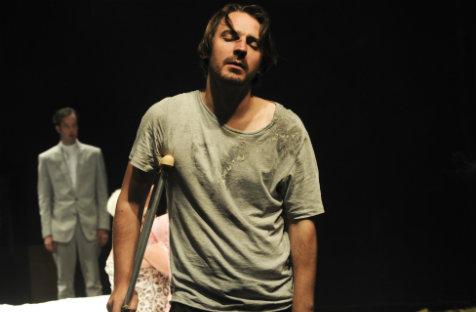In a bow to mild mid-century tastes and severe censorship, Tennessee Williams rewrote the ending for Cat on A Hot Tin Roof. When I got wind that Simon Stone, the enfant terrible of Australian theatre, would be directing Williams’ original masterpiece, I was anticipating greatness.
In his Director’s Note, Stone writes, ‘The play should appear to be written expressly for this audience in this particular time and place’. To that end, it struck me as something of a lapse in logic that the world of the play, a wealthy 1950s Mississippi Delta cotton plantation, was populated with contemporary Australians. To ‘strip it back to its timeless core’ surely one has to adapt Cat for modern audiences, as Stone did to great success with Senecas’ Thyestes. There, Stone unpicked the play’s sententiousness and refreshed the script with banal hipster babel, machismo-charged homoeroticism and gender-bending performances. This was exactly the kind of radical re-imagining called for to breathe new life into Seneca’s 1st century spectacle.
Stone’s Cat on a Hot Tin Roof is far from a flop. There is much to admire in its performers and its design despite Stone’s limited imagination. I’ve come to expect immediacy and boldness from this director – the likes of relocating the play to Western Australia and replacing cotton farming with mining.
Families fighting over money is always current, so in that regard this play is a classic. But, without wanting to reveal major plot elements, exposing one’s alternative sexual identity is not the taboo it once was. When maters of patrilineage enter the fray, perhaps. But in this circumstance, the character is unfazed by the prospect of having no claim to a family inheritance; the fear is reconciling his sense of self.
The play opens with an unhappily married couple, Maggie and Brick (Jacqueline McKenzie and Ewen Leslie) readying themselves – bracing themselves – for the birthday celebrations of Brick’s father, the family patriarch, Big Daddy (played with script in hand by Marshall Napier who stepped up at the last minute when illness forced Anthony Phelan to step down). Maggie’s hysterical ranting against Brick’s morbid despondency is a little too obviously an exercise in juxtaposition. This lengthy, wordy, highly-strung two-hander tried and lost the patience of the audience; a number of whom didn’t return to their seats after interval to see Leslie unleash Brick’s fury and burn with the intensity of magnesium.
Audience feedback is a fascinating thing. Older female members of the audience responded to Big Daddy’s despicable mouthing-off, lines like, ‘I don’t like my wife, never have. She don’t look good, smell good, taste good, but I still lay her regular as a piston,’ with laughter. Perhaps they’re laughing because it’s so over-the-top. But I wonder if it’s a nervous, defensive laughter in the face of an all too familiar picture of a family in ruins. A reaction of a piece with the larger-than-life laughter that Big Mama (played brilliantly by Lynette Curran) summons to deflect the torrent of barbs and stings and loathing that flood the grand halls of the family manor.
It’s hard to find child actors with the balance of confidence and vulnerability to produce strong performances. I know I’ll sound callous by admitting this (perhaps less so in the wake of The Onion’s recent remarks about eight-year-old Oscar nominee Quvenzhané Wallis) but the children in this production are lousy. This is not to say these young performers won’t come into their own in the fullness of time, but the supposed ‘no-neck monsters’ have none of the ratbag menace the script calls for, just contrived cutesiness. It’s apparent they have sweet singing voices, but even then nerves get the better of them.
When the family feud reaches crescendo, the instinctive way in which a group disperse about a room in the heat of an argument, finding corners to hide in and fight from, is brilliantly captured by designer Robert Cousins’ use of a revolve stage that allows us to glimpse each of the characters from differing perspectives. The intensity of the silence and stillness that follows the storm is wonderfully heightened by the soft whir of the slowly rotating stage. But a rotating stage is not the radical shift in time and space that this play needs.
Rating: 3 ½ stars out of 5
Cat on a Hot Tin Roof
By Tennessee Williams
Director: Simon Stone
Set Designer: Robert Cousins
Costume Designer: Alice Babidge
Lighting Designer: Damien Cooper
Composer & Sound Designer: Stefan Gregory
Associate Sound Designer: Caitlin Porter
Assistant Director: Kit Brookman
Cast: Ruby Alexander, Alex Chorley, Oscar Clarke, Lynette Curran, Gareth Davies, Alan Dukes, Ewen Leslie, Bonnie FitzGerald, Rebecca Massey, Jacqueline McKenzie, Marshall Napier, Ella Nicol, Justin Smith and Natalie Theodore
Belvoir St Theatre, Surry Hills
16 February – 21 April
Extra performances now available at Theatre Royal





